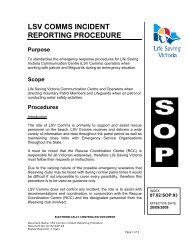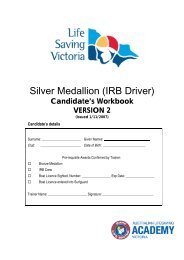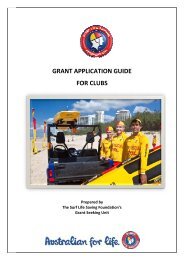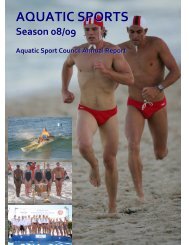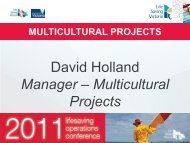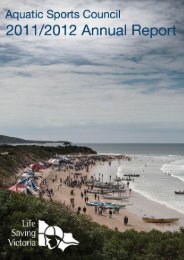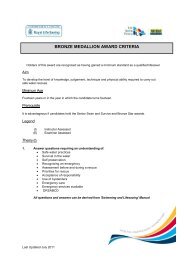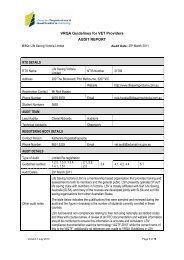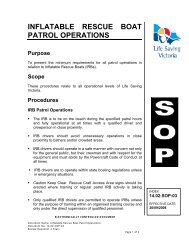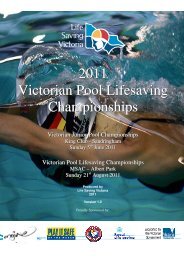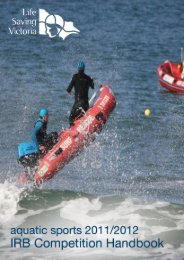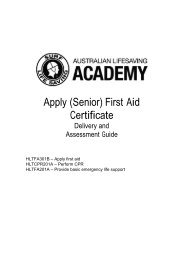Peter Agnew - 33rd Edition Training Manual - Life Saving Victoria
Peter Agnew - 33rd Edition Training Manual - Life Saving Victoria
Peter Agnew - 33rd Edition Training Manual - Life Saving Victoria
Create successful ePaper yourself
Turn your PDF publications into a flip-book with our unique Google optimized e-Paper software.
Introduction of the <strong>33rd</strong> <strong>Edition</strong><br />
of fthe<br />
Public Safety and<br />
Aquatic Rescue<br />
<strong>Training</strong> <strong>Manual</strong><br />
<strong>Peter</strong> <strong>Agnew</strong><br />
General Manager Operations
What are these?
Did you know?<br />
If Facebook was a country it would be the<br />
4 th largest in the World
Did you know?<br />
The top 10 jobs demanded in 2010<br />
didn’t exist in 2004
Did you know?<br />
The number of text messages sent each day<br />
The number of text messages sent each day<br />
out numbers the population of the World
Did you know?<br />
The amount of new technical information is doubling<br />
every two years<br />
For students starting a four year technical degree<br />
this means…..<br />
H lf f h t th l i th i fi t f t d ill<br />
Half of what they learn in their first year of study will<br />
be outdated by their third year of study
Did you know?<br />
In 1998 Australia’s richest man donated to a state ambulance<br />
service 32 lifesaving machines that the state government<br />
could not afford<br />
What were they?<br />
Defibrillators
Did you know?<br />
Today in the US a Defib is supplied with most<br />
Today in the US a Defib is supplied with most<br />
boat purchases!
What does this all mean?
Shift Happens!
Changes for SLS<br />
• Government education framework<br />
• Legislation<br />
• Australian Resuscitation Council<br />
• International <strong>Life</strong>saving Federation<br />
• Internal demands and expectations<br />
• Developments in technology<br />
• Generational changes
The Review Process<br />
• Submissions called for review of 32nd<br />
<strong>Edition</strong> in 2007<br />
• National Editorial panel appointed<br />
• Changes presented to National Board of<br />
<strong>Life</strong>saving<br />
• <strong>Manual</strong> updated and signed off by each<br />
<strong>Manual</strong> updated and signed off by each<br />
state in July 2009
Bronze Medallion and SRC<br />
Content<br />
• Bronze/ Cert II are required to cover content<br />
of each chapter from 1 August 2009<br />
• SRC candidates do not complete<br />
– Chapter 5 – Defibrillation and basic<br />
oxygen<br />
– Chapter 7 – Radio Operations<br />
– Chapter 10 – Carries and Support
Workbooks and Assessment<br />
Structure<br />
• Workbook used in some states has been<br />
discontinued based on feedback<br />
• This will reduce additional administration<br />
requirements for this award<br />
• A more “hands on” training and assessment<br />
o e a ds o t a g a d assess e t<br />
structure is recommend
Major Changes<br />
• Name Change – <strong>33rd</strong> <strong>Edition</strong> Public Safety and Aquatic<br />
Rescue <strong>Training</strong> <strong>Manual</strong><br />
• Induction checklist contained in prelims<br />
• Self Survival skills of floating and treading water added<br />
• Three systems have been added to anatomy and physiology<br />
to meet the unit of competency<br />
• The First Aid content is now contained in one chapter (not<br />
split into Basic FA and FA<br />
• Defibrillation awareness and use has been added to the<br />
Bronze/Cert II<br />
• The three person carry has been removed – use two person<br />
carry or stretcher carry
Major Changes (cont.)<br />
• The five person spinal carry is included for information only<br />
but is not assessable<br />
• The double tube tow has been introduced<br />
• New terminology to replace “Jaw Lift” – now called “Chin Lift”<br />
• Back blows are no longer used on a patient who is<br />
unconscious with a blocked airway
Defibrillation Implementation<br />
Issues<br />
Why the change<br />
• Development of AED’s over the past 10 years<br />
• Change in Australian Resuscitation Guidelines<br />
• Broader community approach to public access to defibrillation<br />
Scope of defibrillation training and assessment<br />
• Content with Chapter 5<br />
• Keep it simple<br />
– Prepare the patient<br />
– Attach pads<br />
– Press start and follow prompts<br />
p<br />
– Understand safety<br />
As per Circular 43/08-09 09 clubs will need to buy a defibrillator unit.<br />
See SLSA website under Gear and Equipment for approved suppliers
Who can train and assess<br />
defibrillation within the<br />
Bronze/Cert II<br />
BM trainers and assessors can now train defib awareness<br />
Some ways to up skill:<br />
• Read the text within the new manual<br />
• Conduct an in-service i with an existing defib operator or<br />
facilitator<br />
• Attend the defibrillator operator course
Upgrades for existing active<br />
patrol members<br />
2009 - Bronze Medallion proficiency should include defib<br />
awareness and use<br />
2010 – Bronze Medallion proficiency tests must include defib<br />
awareness and use
Content changes by chapter
Introduction
Chapter One: Safety and<br />
Wellbeing
Safety & Wellbeing
Safety & Wellbeing
Chapter Two: Surf Awareness<br />
and Skills
Surf Awareness & Skills
Surf Awareness & Skills
Surf Awareness & Skills
Chapter three: Anatomy and<br />
Physiology
Chapter Four: Resuscitation
Resuscitation
Resuscitation
Resuscitation – Back Blows<br />
• Back Blows are no longer used on an unconscious patient<br />
who has a suspected blocked airway and who has no signs of<br />
life – perform CPR<br />
• Back blows can still be used for a blocked airway in a<br />
conscious patient but this treatment is not contained within the<br />
Bronze Medallion/SRC (it is in the First Aid Certificate)
Chapter Five: Defibrillation and<br />
Basic Oxygen
Defibrillation and Basic Oxygen
Chapter Six: First Aid
First Aid
First Aid
First Aid
Chapter Seven: Radio<br />
• Limited changes
Chapter Eight: Communications
Chapter Nine: Rescue<br />
Techniques
Rescue Techniques
Rescue Techniques
Rescue Techniques
Rescue Techniques
Chapter Ten: Carries and<br />
Supports<br />
• Removed three person carry<br />
• Five person spinal carry now removed based on feedback for<br />
International <strong>Life</strong>saving Federation
Chapter Eleven: Patrols
Patrols
Patrols
Further Information or feedback<br />
For further information see SLSA Circular 01/ 09-10<br />
Feedback on Version 2 of the manual starts now<br />
Contact t your State t Education Manager/Director or<br />
<strong>Peter</strong> <strong>Agnew</strong> at SLSA 02 9300 4000



